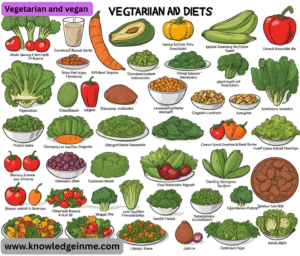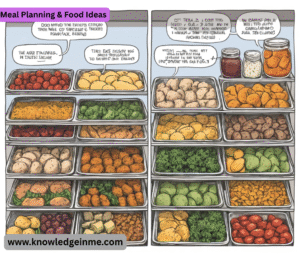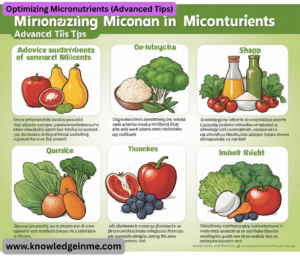Vegetarian and vegan diets Vegetarian and vegan diets are plant-based eating patterns that exclude certain or all animal products. Here’s a breakdown of their differences, benefits, and considerations:
Types of Vegetarian Diets
- Lacto-ovo vegetarian: No meat, fish, or poultry, but includes dairy and eggs.
- Lacto-vegetarian: No meat, fish, poultry, or eggs, but includes dairy.
- Ovo-vegetarian: No meat, fish, poultry, or dairy, but includes eggs.
- Pescatarian (not strictly vegetarian): No meat or poultry but includes fish, dairy, and eggs.
- Flexitarian: Mostly plant-based but occasionally includes meat or fish.
Vegan Diet
- Excludes all animal products: meat, fish, poultry, dairy, eggs, honey, and often gelatin or other animal-derived ingredients.
- Focuses on fruits, vegetables, grains, legumes, nuts, seeds, and plant-based alternatives (e.g., tofu, tempeh, almond milk).
Health Benefits
- Heart health: Lower saturated fat and cholesterol, reducing heart disease risk.
- Diabetes risk: May improve insulin sensitivity and reduce type 2 diabetes risk.
- Digestive health: High fiber intake supports gut health.
- Cancer risk: Some studies link plant-based diets to lower cancer rates.
Nutritional Considerations
- Protein: Can be obtained from beans, lentils, tofu, quinoa, nuts, and seeds.
- Vitamin B12: Found only in animal products; vegans need fortified foods or supplements.
- Iron: Plant-based iron (non-heme) is less absorbable; pair with vitamin C (e.g., citrus, bell peppers) for better absorption.
- Calcium: Vegans should consume fortified plant milks, leafy greens, almonds, or tahini.
- Omega-3s: Found in flaxseeds, chia seeds, walnuts, and algae-based supplements.
- Vitamin D: May require supplementation, especially in low-sunlight areas.
Environmental & Ethical Impact
- Lower carbon footprint than meat-based diets.
- Reduces animal suffering by avoiding factory farming.
- Less water and land usage compared to animal agriculture.
Potential Challenges
- Social situations: Limited options at restaurants or gatherings.
- Convenience: Requires more meal planning, especially for vegans.
- Nutrient deficiencies: Risk if not properly balanced (e.g., B12, iron, calcium).
Tips for Transitioning
- Start with Meatless Mondays or gradually replace animal products.
- Experiment with plant-based recipes (e.g., lentil curry, chickpea stir-fry).
- Read labels for hidden animal ingredients (e.g., whey, casein, gelatin).
- Consult a dietitian to ensure nutritional adequacy.
Meal Planning & Food Ideas
Vegetarian Staples:
- Breakfast: Greek yogurt with berries, oatmeal with nuts, scrambled eggs with spinach.
- Lunch: Lentil soup, chickpea salad sandwich, quinoa bowl with roasted veggies.
- Snacks: Hummus with veggies, cheese and whole-grain crackers, hard-boiled eggs.
Vegan Staples:
- Breakfast: Chia pudding, avocado toast, smoothie with almond milk and peanut butter.
- Lunch: Buddha bowl (grains + beans + veggies + tahini), vegan lentil curry, jackfruit “pulled pork” sandwich.
- Dinner: Mushroom risotto, tempeh stir-fry, vegan chili with cornbread.
- Snacks: Roasted edamame, nut butter with apple slices, dairy-free dark chocolate.
Debunking Common Myths
- Myth 1: “Plant-based diets lack protein.”
- Truth: Beans, lentils, tofu, seitan, and quinoa provide ample protein. Even veggies like broccoli and spinach contain some.
- Myth 2: “Vegans are always deficient in nutrients.”
- Truth: With planning (B12 supplements, iron-rich foods), deficiencies are avoidable.
- Myth 3: “Plant-based = expensive.”
- Processed vegan meats/cheeses can be pricey, but aren’t necessary.
Eating Out & Traveling
Restaurants:
- Look for ethnic cuisines (Indian, Thai, Mediterranean) with veg-friendly options.
- Ask for modifications (e.g., swap cheese for avocado, omit fish sauce).
Travel Tips:
- Pack snacks (nuts, protein bars).
- Use apps like Happy Cow to find veg-friendly eateries.
Fitness & Plant-Based Diets
- Athletes can thrive on vegan/vegetarian diets (e.g., Serena Williams, Lewis Hamilton).
Key tips:
- Prioritize protein timing (post-workout smoothie with pea protein).
- Eat iron-rich foods + vitamin C to prevent fatigue.
- Include healthy fats (flaxseeds, walnuts) for endurance.
Pregnancy & Kids on Plant-Based Diets
Possible but requires care:
- Pregnancy: Need extra B12, iron, DHA (algae oil), and folate.
- Kids: Ensure enough calories, protein, and fat (e.g., nut butters, fortified plant milk).
- Consult a pediatric dietitian for guidance.
Environmental Impact (By the Numbers)
- 50%+ lower greenhouse gas emissions vs. meat-heavy diets (Oxford study).
- 1,000+ gallons of water saved per day by going vegan (waterfootprint.org).
Ethical Considerations
- Animal welfare: Avoids factory farming practices.
- Labor rights: Plant-based agriculture often has fewer ethical concerns than industrial meat production.
How to Make the Switch Easier
- Phase out gradually: Start with dairy-free milk or meatless lunches.
- Find swaps you love: Try cashew cheese, Beyond Burgers, or coconut yogurt.
- Join communities: Reddit’s r/vegan or local veg groups for support.
When It Might Not Work
- Medical conditions: Certain gut issues (e.g., IBS) may require low-FODMAP adjustments.
- Eating disorders: Restrictive diets can trigger relapses—seek professional guidance.
Must-Try Recipes
- Vegan “Cheesy” Cauliflower Bake (nutritional yeast-based sauce).
- Chickpea “Tuna” Salad (mashed chickpeas + vegan mayo + celery).
- Lentil Walnut Tacos (protein-packed meat substitute).
Optimizing Micronutrients (Advanced Tips)
- Iron Boost: Soak beans/lentils before cooking to reduce phytates (which inhibit absorption). Pair spinach with lemon juice.
- Zinc Hack: Sprout grains/seeds to enhance bioavailability. Pumpkin seeds are a great source.
- Calcium Trick: Use calcium-set tofu (check label), blend sesame seeds (tahini) into sauces.
- Iodine Source: Use iodized salt or eat seaweed snacks (but don’t overdo it—excess iodine can be harmful).
Global Plant-Based Cuisines to Explore
- Indian: Dal (lentil curry), chana masala, dosas (fermented lentil/rice crepes).
- Japanese: Vegan sushi (cucumber/avocado), miso soup with tofu, edamame.
- Mexican: Nopales (cactus) tacos, vegan pozole (hominy stew).
- Middle Eastern: Falafel, mujadara (lentils + rice + caramelized onions).
Pantry Essentials Checklist
Proteins:
- Canned chickpeas, black beans, lentils.
- Textured vegetable protein (TVP), tempeh, vital wheat gluten (for seitan).
Grains & Starches:
- Quinoa, farro, brown rice, whole-wheat pasta.
- Sweet potatoes, buckwheat flour.
Healthy Fats:
- Extra virgin olive oil, flaxseeds, chia seeds, avocado.
Dairy Alternatives:
- Fortified almond/soy/oat milk, nutritional yeast (“vegan cheese” flavor).
- Condiments & Flavor Boosters:
- Tamari (gluten-free soy sauce), tahini, coconut aminos.
- Smoked paprika, liquid smoke, miso paste.
1-Day Sample Meal Plan (High-Protein Vegan)
Breakfast:
- Vegetarian and vegan diets Tofu scramble with turmeric, black salt (for eggy flavor), sautéed kale, and whole-grain toast.
Snack:
- Chia pudding made with soy milk + 1 tbsp almond butter + berries.
- Pre-Workout Snack:
- Banana with a handful of walnuts.
Dinner:
- Lentil-walnut “meat” bolognese over zucchini noodles.
Dessert:
- Dark chocolate-covered almonds + peppermint tea.
- (~1,800 kcal, 80g protein)
Cheap & Easy College Student Meals
- Microwave Lentil Mug Soup: Lentils + veggie broth + frozen veggies + cumin.
- Peanut Butter Banana Wrap: Whole-wheat tortilla + PB + banana + cinnamon.
- Instant Ramen Hack: Add tofu, frozen peas, and sriracha to vegan ramen.
Plant-Based “Hacks” for Meat Lovers
- Mushrooms: Portobellos mimic steak texture when grilled.
- Jackfruit: Shredded for “pulled pork” sandwiches.
- Lentils + Walnuts: Finely chopped as a ground meat substitute.
- Aquafaba: Chickpea brine whips like egg whites (for meringues).






